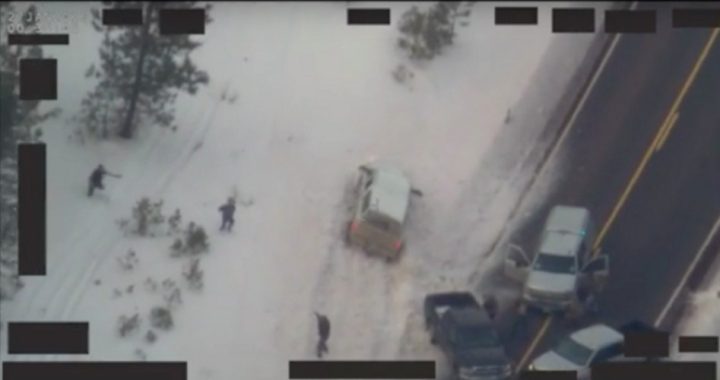
If federal authorities thought the release of the aerial video of the shooting of Arizona rancher/protester LaVoy Finicum would quell rumors, debate, and speculation about what really happened, they greatly misjudged the impact of the video. Although many observers have been quick to claim that the video images vindicate the FBI/police version of the shooting, just as many viewers, apparently, see in it confirmation of the contradictory story presented by eyewitness Victoria Sharp, or at least see many discrepancies that make the video fall far short of answering some of the most critical questions about the event.
The grainy and often out-of-focus video, taken from an FBI plane, is 28 minutes and 26 seconds long. It purports to document the attempted roadblock arrest of Finicum on Tuesday, January 26, along a wooded stretch of U.S. Highway 395 in eastern Oregon. The title on the FBI’s YouTube site, where the video is posted, says “Complete, Unedited Video of Joint FBI and OSP [Oregon State Police] Operation 01/26/2016”
The detailed description beneath the video states:
Published on Jan 28, 2016
This is the complete video footage of a joint FBI and Oregon State Police traffic stop and OSP officer-involved shooting of Robert “LaVoy” Finicum on the Malheur National Wildlife Refuge. This footage, which has only been edited to blur out aircraft information, was taken by the FBI on 01/26/2016 and released by the FBI on 01/28/2016. Note regarding date/time stamp in the left corner of video: Pilots use Zulu Time, also known as Greenwich Mean Time (GMT), when they fly. Zulu time is eight hours ahead of Pacific Standard Time (PST). Therefore, although tthis footage was taken on January 26, 2016 in Oregon, the date/time stamp on the video shows just after midnight January 27, 2016.
At a public press conference announcing the release of the video (on Thursday, January 28), Greg Bretzing, Special Agent in Charge of the FBI in Oregon, said that, in spite of the graphic details included in the video, “we feel that it is necessary to show the whole thing unedited in the interest of transparency.”
At the press conference, Special Agent In Charge Bretzing provided this decription of the most crucial seconds of the film:
As [Finicum’s] truck approaches the roadblock, there is a spike strip across the road but it appears Finicum missed it as he attempted to drive around the roadblock. He nearly hits an FBI agent as he maneuvers to the left. The truck gets stuck in the snowbank.
Finicum leaves the truck and steps through the snow. Agents and troopers on scene had information that Finicum and others would be armed. On at least two occasions, Finicum reaches his right hand toward a pocket on the left inside portion of his jacket. He did have a loaded 9 mm semi-automatic handgun in that pocket.
At this time, OSP troopers shot Finicum.
Approximately 30 seconds after the shooting, law enforcement officers at the scene deployed flash bangs to disorient any other armed occupants. Shortly after that, they deployed less-lethal sponge projectiles with OC capsules. Those OC capsules would be similar to pepper spray.
“Over a period of several minutes,” Bretzing continued, “agents and troopers worked to safely remove the remaining truck occupants, and to take them into custody…. As soon as the agents and troopers were confident that they had addressed any further threats, they provided medical assistance to Finicum. That happened about 10 minutes after the shooting.”
Does the video support the version outlined by FBI’s Bretzing? Well, as often is the case, that is in the eye of the beholder. The images are fuzzy and blurry much of the time and the camera jumps about going in and out of focus. Moreover, much of the time the images are quite small, taken from a long distance up. Was Finicum “charging” the police, as Mark McConnell (who was not a witness) alleges, or was he walking toward the police with his hands up, as Victoria Sharp claims?
The initial images, as he exits the driver’s seat of the truck, could support either version. Shortly thereafter, Finicum’s right hand does appear to drop toward the direction of his left pocket, but some observers point out that he may have merely been trying to maintain his balance in the deep, slippery snow. Or, his movement may have actually been the involuntary physical reaction to having already been shot. Since the video does not have an audio recording, we do not know if he may have already been shot when he made that movement.
That brings us to the many additional unanswered questions, such as:
• In an operation of this size, with all of the local, state, and federal resources and manpower deployed, were there no other video or audio recordings?
• Were there no dash-cams on the vehicles or body-cams/body-mics on the troopers and FBI agents?
• Where is Finicum’s truck and has there been any independent verification of the number of bullet holes in it?
It is highly unlikely that there are not additional video and audio recordings. According to Victoria Sharpe’s account, there were over 100 shots fired, none of which were fired by the occupants of Finicum’s vehicle. Taking into consideration her age (18 years old) and the trauma of the situation, it could be that she may have imagined more shots than actually were fired, but it does not seem probable that she was so hysterical (or dishonest) as to transform 4 or 5 shots into more than 100.
We will have a more thorough analysis of the FBI video and related evidence in following stories.
Related articles:
Oregon Standoff – Bundy Says Stand Down, As Others Call to Action
Oregon Standoff – Rancher LaVoy Finicum Shot Dead by Police



